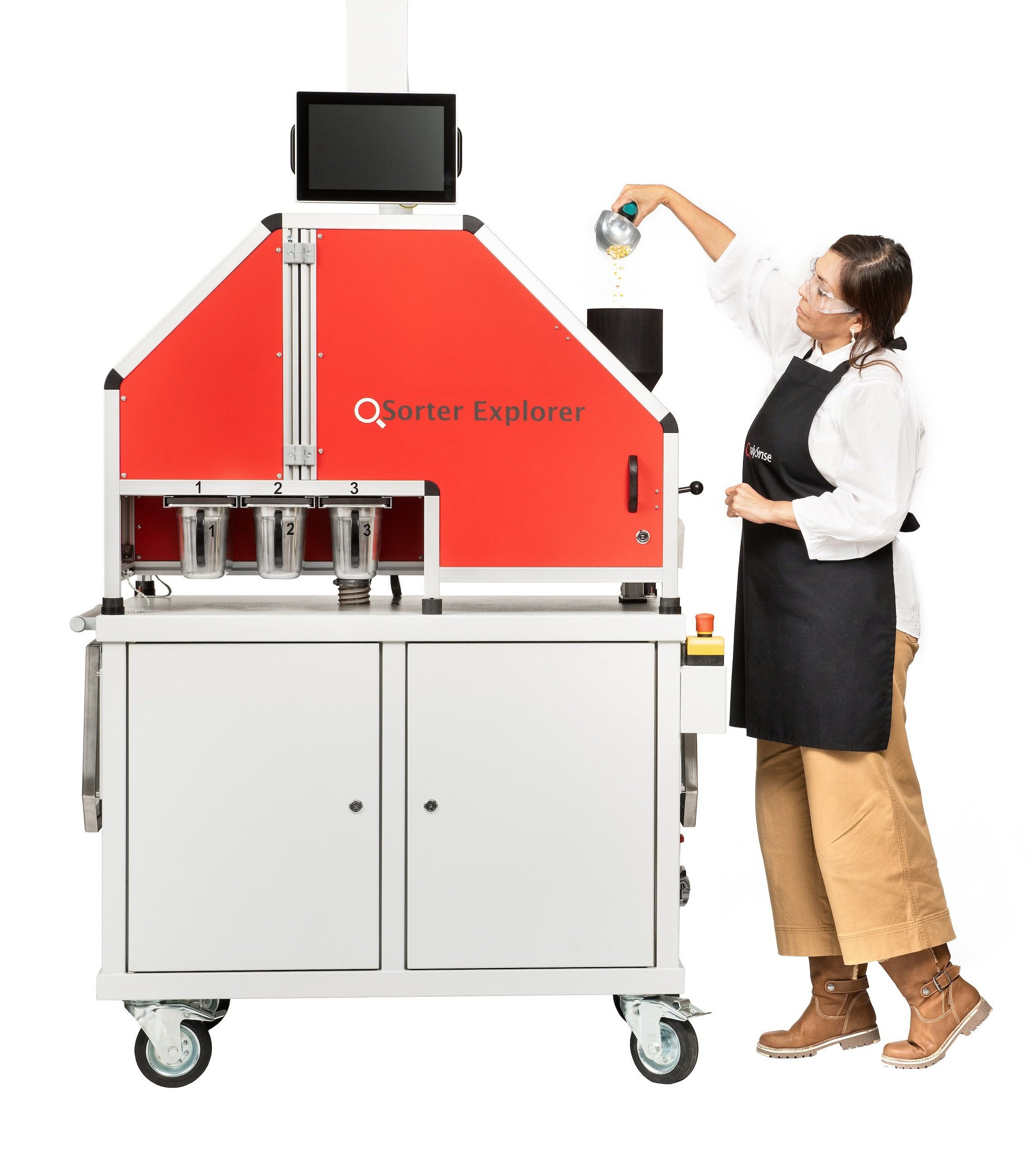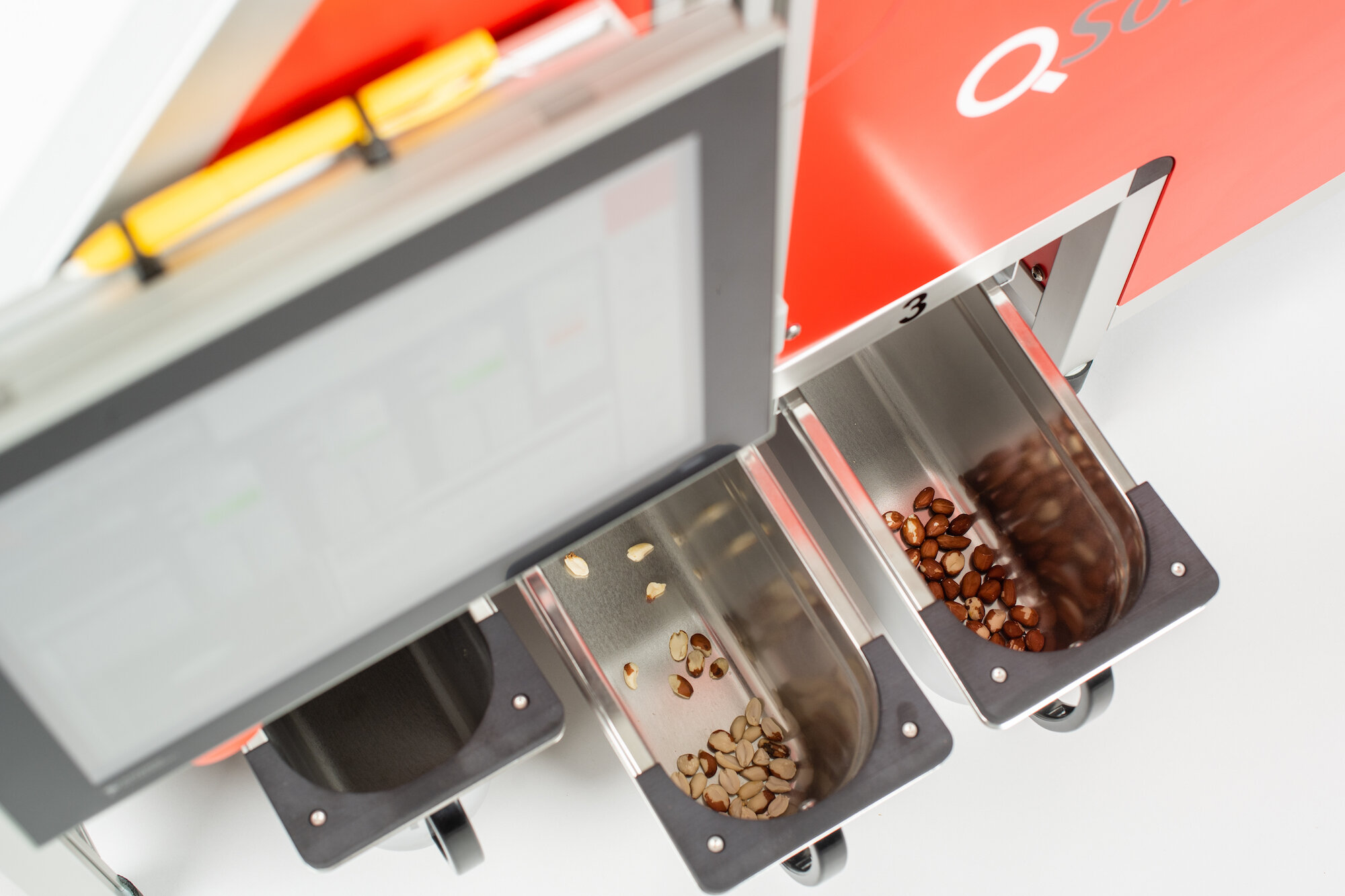QSorter® Explorer
The most advanced single bean robot for quality inspection and breeding

Large Quality Datasets, Accuracy and Innovation

Non destructive analysis and sorting at the speed of light
How the QSorter® Works
Easy steps for comprehensive quality data
1
Insert one or several thousands of seeds
2
Run QSorter® and generate quality results in minutes
3
Sort the sample in classes for further detailed experiments
4
Share inspection and analysis reports over the cloud
Solutions for all needs
Ultra Fast Breeding
QSorter® Explorer can be applied to select seeds in a non-destructive way with respect to several compositional and physical parameters. Whether you are breeding soybeans, corn, sunflower seeds, wheat, or any other commodity, you will find it very useful to deepen the understanding of the key breeding parameters, run multiple and complex sorting experiments, create larger and targeted populations, and run field trials with a much higher chance of success. This results in strong savings with wet chemistry analyses reduces seed waste by up to 80%, and accelerates breeding cycles. Today, major seed companies are using the QSorter® Explorer to develop tailored breeding programs and advance faster with experiments.
Automatic Inspection
QSorter® Explorer can inspect each kernel accurately with respect to biochemical (e.g. protein, moisture, oil, sucrose) and physical (e.g. color, size, shape, defects) parameters. Thanks to the very high speed, samples can be inspected in a few minutes. Once the sample is inserted into the hopper, the QSorter® Explorer can (1) separate the sound kernels from the visually defective kernels, (2) analyze the samples for protein, moisture, oil, and other compositional parameters, (3) measure additional key quality features such as weight, size and (4) report all the findings in a digital quality report that can be shared with all relevant stakeholders. Companies can save 80% time or more in visual inspection, reduce drastically the subjectivity error, inspect more in-depth for higher confidence, and replace other laboratory instrumentation. This results in huge cost savings and much higher accuracies.
Research & Development
Are you developing new food, seeds, or drink products? Are you trying to understand why the consistency of your process keeps varying? The QSorter® Explorer can enable to run tons of experiments and to test your assumptions in no time. We have several solutions for coffee beans, oats, corn, soybeans, rice, and many other commodities. Our advanced technology allows you to physically isolate kernels with specific biochemical and/or physical properties so that targeted experiments can be conducted. The experiments are non-destructive and non-invasive so that no alteration is introduced into the trials. The large amount of data produced by the QSorter® Explorer can be used to run several statistical analyses on the samples, helping you debug the outcome of the experiments. Thanks to its multiple functions, the QSorter® Explorer is an advanced and cost-effective research tool that can be easily integrated into your laboratory but also along the processing lines to verify the consistency and the performance of all your processing equipment.
Technical Specifications
| Parameter | Value |
|---|---|
| Sensing and Sorting | |
| Sensing technology | High-speed RGB color camera |
| Sensing technology | Near infrared spectrometer (NIR) 900 – 1700 mm |
| Pneumatic shooting accuracy | > 98% |
| Weight and Dimensions | |
| Weight of the device | 320 kg / 705 lb |
| Length (tables open) | 1'292 (1'909) mm / 50.9 (75.2) in |
| Width (tables open) | 768 (2'104) mm / 30.2 (82.8) in |
| Height (touch panel included) | 1'720 (2'050) mm / 67.7 (80.7) in |
| Power Supply | |
| Voltage | 110 – 120 / 200 – 240 VAC |
| Frequency | 50 / 60 Hz |
| Rated power | 2'000 VA |
| Fuse cut-out | 20 / 16 A |
| Power cord | 5 m / 16.4 ft long Hz |
| Compressed air | |
| Compressed air connection pressure | 5.5 – 8 bar / 80 – 116 PSI |
| Compressed air flow | Nominal 150 l/min / 4.2 cfm |
| Quality (min. requirement) | Class: 7:4:4 (ISO 8573:1:2010) – Dryer necessary |
| Connection | Standard (push-in) 8 mm pneumatic tube (5m / 16 ft long) |
| Ambient Conditions | |
| Ambient operating temperature | 10 – 40 °C / 50 – 104 °F |
| Ambient non-operating temperature | -10 – 60 °C / 14 – 140 °F |
| Humidity | less than 31% °C (87 °F) 10 – 80% |
| Operating altitude | Up to 2'000 m / 6'562 ft |
| Non-operating altitude | Up to 4'600 m / 1'5000 ft |
| Noise level | 68 dBA |
| Air quality environment | Laboratory |
| Connectivity | |
| Connectivity options | Ethernet port, Wi-Fi, 4G |







